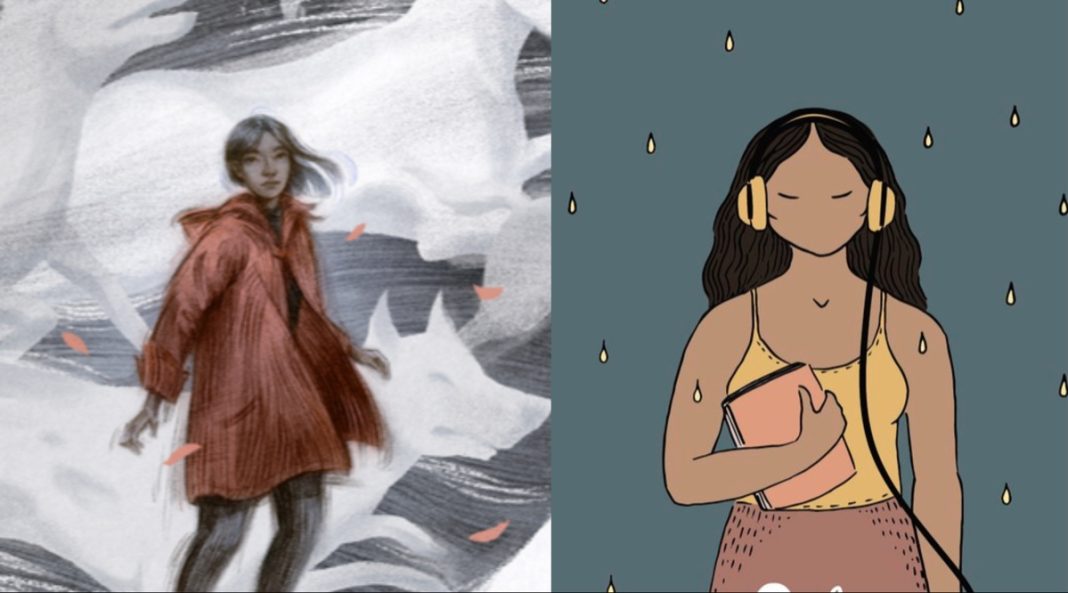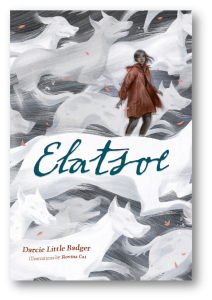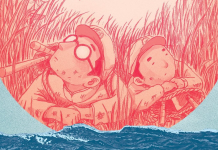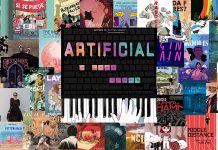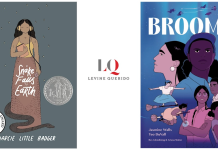By Jim McDermott
In August of 2020, Dr. Darcie Little Badger, an oceanographer and member of the Lipan Apache with a passion for fantasy writing, had her first novel published. Entitled Elatsoe [pronounced eh-LAT-sew-ay], the book told the story of Elatsoe, aka Ellie, a 17-year-old Lipan Apache girl who had inherited the family’s ability to conjure up the spirits of deceased animals, who hunts down the murderer of her cousin. In style the book had the world-building and playfulness of Nnedi Okorafor or Seanan McGuire, but its deepest roots lie in the stories, culture and historical traumas of the Apache people.
The book was a massive hit. Time named it one of the 100 best fantasy novels of all time. Since then, Little Badger has produced a second novel, A Snake Falls to Earth, with an entirely different cast of characters. But next year she is returning to the world of Elatsoe’s family—specifically the childhood of her grandmother—in the novel Sheine Lende.
I had the chance to speak to Little Badger by phone, just after she had returned from San Diego Comic-Con 2023.
This interview has been edited and condensed for clarity.
This was your first Comic-Con right?
That’s right. I was originally invited as a special guest for 2020, but then you know what happened… So, they invited me back.
What did you think?
I was actually very impressed. I was a little bit worried that it would be overwhelming: I love being around people and interacting, but I was also a little bit worried that it would be so big that I would get lost and swept away and end up on the other side of San Diego.
That didn’t happen. For such a big convention they did a great job keeping it pretty organized.
I used to volunteer at Comic-Con, and I was always so amazed at how the volunteers basically make it all work.
That’s definitely what I experienced. As an invited guest there was someone who was helping me get to the panels named Gabby, and I have to say knowing that these people were giving up their time to make it a smooth experience for me, I was just very grateful for that.
Thanks so much for taking the time after all that to talk to me. I was so excited to hear that you’re doing a prequel to Elatsoe. What is it that made you want to go back to the story of Ellie’s family?
There’s a couple of aspects to that. When I was writing the first draft of Elatsoe, I thought it would be a three book-type trilogy. There were always things about the world that we didn’t end up exploring. I guess you can say that with any fantasy; there’s only so many pages.
I didn’t know whether I’d have the chance to return to that world. But then Elatsoe was published and the response was just so cool, we realized maybe readers would be into another book.
I think I was on a phone call with some folks with [Elatsoe publisher] Levine Querido, and Arthur Levine was like why don’t you write another one about one of Ellie’s family? Because she’s descended from this line of women who could raise the ghosts of animals throughout time. So it was that.
But also the 1970s in particular, they’re a very interesting time, not just for my personal family, but the Lipon community in Texas. So I saw the potential to incorporate in a fantasy world way some of the real historical context of that period into the main character’s backstory and also her main plot.
What is it about the ‘70s in Texas interested you?
During the ‘70s there were more efforts to very publicly connect with the community around us in a way that was acknowledging our role. For example in McCallum, Texas there’s this powwow that’s been going on for fifty years, and it’s a specifically Lipon Apache powwow. It started in the ‘70s.
In other ways, too, it was a time when we’d gotten past the violent elimination campaigns of the late 1800s. But there were still a lot of difficulties in place. And I was thinking, if anything had gone differently for my family, maybe I would not be here, or maybe I would not know who I was.
What do you mean?
When Hurricane Beulah hit, it was one of the worst catastrophic environmental disasters that McCallum had ever faced. There was horrible flooding. And unfortunately the worst brunt of that was experienced by Native border communities and these communities of low income people that had immigrated from Mexico called colonias.
And there’s some questions about how much the design of the levees or flood mitigation systems actually impacted that. Like was there a prioritization of certain parts [of town]?
My family lost their home, and it ended up causing great deaths in my family. It was a hard time. And I was just thinking, we were finally reaching this place where we could be public about our culture and our language and our ceremonies without being worried about being killed, but there were these other elements of trying to survive. I thought this would be an interesting thing to explore, and just the nature of how to persist through times like that.
I think also it’s a lesser-known period. A lot of people know what happened to the Native people or the Lipon specifically during the late 1800s. But once you reach the 1900s, we’ve had very well documented history, but it’s just not taught. So I was like, yeah, let’s do something in the 1900s.
That sounds really powerful. And it reminds me of one of the aspects of Elatsoe that is just so striking: you have the capacity to talk about very, very hard, painful things, and yet somehow your work maintains this tremendous sense of hope. How are you able to maintain that balance between hope and the historical realities?
With Elatsoe I was very much writing, What if this girl was seeking justice and then attained it? So it’s a little bit—I wouldn’t say wish fulfillment, but I didn’t want to write a book where all of her efforts went to nothing. Because I think for a lot of young readers, Native readers, all sorts of readers honestly, it’s hard to enough for them to just get through their day to day, especially when they’re dealing with issues of injustice in their family or loss. I wanted to give them a reason to hope and to keep fighting.
I’ve kind of gotten into the importance of hope, and how I’ve seen in my own life that it is essential. In some situations there’s really two options: you either keep fighting or all is lost. And I didn’t want people to think that it is inevitable for that loss to happen. It really isn’t. Sometimes tragedies happen, and that’s not fair at all. But you know, if you just assume that that will always be the result of your life, it can make it very difficult.
I have seen the positive things that can come from fighting through pain and fighting through difficult situations. When I write my books I want to give the readers not just a fun adventure but maybe also a way to help them feel a little bit stronger.
For me, I would never write a book where essentially nihilism overcomes all.
Do you find having younger protagonists helps in that regard? It seems like the young people in your stories have a greater sense of what is possible, and that it allows them to overcome horrific things.
I do notice that. I wonder if it has something to do with the longer we live, the more it’s drilled into us how naïve it is to want a better life for yourself or your family. And I’m like, hmm, I wonder what powers would benefit from that mindset?
I just want them to know that it’s not a silly thing to want a better life for yourself and your families. It’s actually something that they deserve.
Another aspect I loved about Elatsoe is the notion of story as it plays out within the novel. It’s clear that story has an educational role, that stories can teach you things about values or identity.
But I also wondered if story in the book or in Lipon Apache culture has the quality of bringing back into existence that past, that it brings into life in the present the people and experiences from back then. Almost like a summoning.
Does that at all match with how you see it?
I definitely think of stories in general as being this really cool kind of vessel for knowledge, but not just knowledge. It really kind of plays into the genre of indigenous futurisms: there’s this emphasis on the continuity between our past and our present and how all of that is going to affect our future. Really, time is connected.
And story is a way to almost connect, the origins of the story, or the points where the story has changed with people who are experiencing the story today and who will maybe pass down the story at a future point.
Something so cool about humans as a species is that ability to tell stories. We aren’t the only species that teaches, but in terms of storytelling, we definitely take the cake.
I spent three years working on the Pine Ridge Indian Reservation. Part of our formation in working in a Lakota culture involved Lakota elders coming to talk to us. And at times I was sort of baffled by the experience, because the way they shared information could be radically non-linear. At times I’d just be wondering, Where are we right now? What is being conveyed?
Reading Elatsoe I found myself realizing, what they were doing was not about communicating a set of data points, but bringing into life this entire universe of stuff. It was like they were unpacking a whole world.
It’s interesting, I’m definitely a fantasy novel writer, and that’s a really different beast than a lot of the traditional stories than I learned growing up (and that I’m still learning honestly; I’m in my 30s and I’m still learning new things).
But it was difficult for me to write the book in a purely linear way. That’s why there are these little interjections where we learned what happened with Six-Great or what happened with Elatsoe’s mother. My editor, when I first had the idea, said, “Hmm, I wonder if this is going to work,” but then he liked it.
With Sheine Leinde, the prequel, something that I’ve been investigating is what happens when we start to lose stories. Elatsoe grew up hearing all these stories. She can remember the river monster that her six-great grandmother fought.
But the character here was displaced from her home when she was very young. She lost her father and grandparents during essentially the same big event.
Her mother is overwhelmed just by the forces of trying to keep her and her brother alive. So there’s not a lot of time for her mother to be teaching them stuff, but also they don’t have their elders any more. Their surviving grandpa, he’s very much a complicated character. He’s not really proud of being Native, he kind of writes it off as being some silly thing. He’s like I’m my own person, whatever. So he can’t really help them with that.
At a lot of points in the book it almost seems like she’s going to go back into a memory of one of these stories—I say memory because I almost treat them like memories. And yet I realize these stories were told to them, they were someone else’s memories that were passed down.
And then the character realizes she can only remember like, the very vague outline of this, or doesn’t remember how it ends. And what I try to show in this book is how that actually makes life and her objective a lot more difficult for her.
It’s fascinating to hear the way you talk about memories. In Elatsoe it definitely feels like we’re hearing Ellie’s memories when she’s remembering stories of Six-Great. Those stories are just so present in her life.
Especially when it’s like, stories of my mother’s youth, it’s almost like I can see them in my head and I guess it feels like memories to me although I know logically these were the stories that she told to me. But when I think about them and all these things that happened to my family, I can see it play out, I can see my family and imagine what they look like.
It’s kind of cool the way the human brain works.
You mentioned your work in the broader context of indigenous futurism. Are there authors or publications you would recommend to people who are interested in reading more?
Abalone Mountain Press is a very small press, it publishes a lot of zines. It’s owned and run by Amber McCrary, a Diné woman, and the work they put out in terms of poetry, art and indigenous futurisms is really wonderful.
I feel like a lot of small presses especially in the world of Native publishing are doing such important work, but sometimes they’re overshadowed by the big presses. I definitely suggest anyone who is interested in indigenous futurisms to go check them out.
Last topic: I read that you grew up watching Star Trek?
I’m married to someone who cosplays Star Wars, loves Star Wars, watches all of the Star Wars series. And I’d say I’m much more of a Trekkie, and probably a lot of that is because my mother was one of the original Trekkies. When the TV series with William Shatner came out she would watch the episodes on TV.
And then when I was a kid I would see Star Trek: Voyager.
Of the shows from your youth—TNG, DS9, Voyager, Enterprise—what was your favorite?
I enjoy the different series for their own unique qualities, but I gotta say, I personally really liked The Original Series. I think it’s because it’s these optimistic star adventures. I haven’t watched that new show with Pike yet, but I’m told it’s very much in the spirit of the original.
Strange New Worlds. Yeah, it is!
Yep, that’s on my TV watch list.
Yeah, the original series was fun, but it also explored the issues that impact us in the every day here and now in very inventive ways, the way that sci-fi and fantasy does.
There’s always the question, Who’s your favorite captain? I always refuse to answer that— but it’s probably Captain Kirk, I’m sorry. laughs
Why Kirk?
His personality was just fun for me.
In the second season of Strange New Worlds, they’ve actually brought on a younger version of the character. Honestly, I couldn’t really believe it would work. Shatner is so iconic. But actually what they’ve done with him is so interesting they’ve kind of sold me.
My mom told me I have to watch it, and I definitely trust her in judgment in terms of Star Trek things.
And I have to say, Kirk is one of those characters I don’t mind seeing different people play. They always bring something unique to him. So now I’m just fascinated.
Darcie, thanks so much for taking the time to talk to me. When does Sheine Leinde come out?
Spring of ‘24. I’m working on the edits now. I never think it’s ready, but I think I just have to let it go at this point.
I can’t wait to see it.
Thank you so much.
Miss any of our earlier SDCC ’23 coverage? Find it all here!


